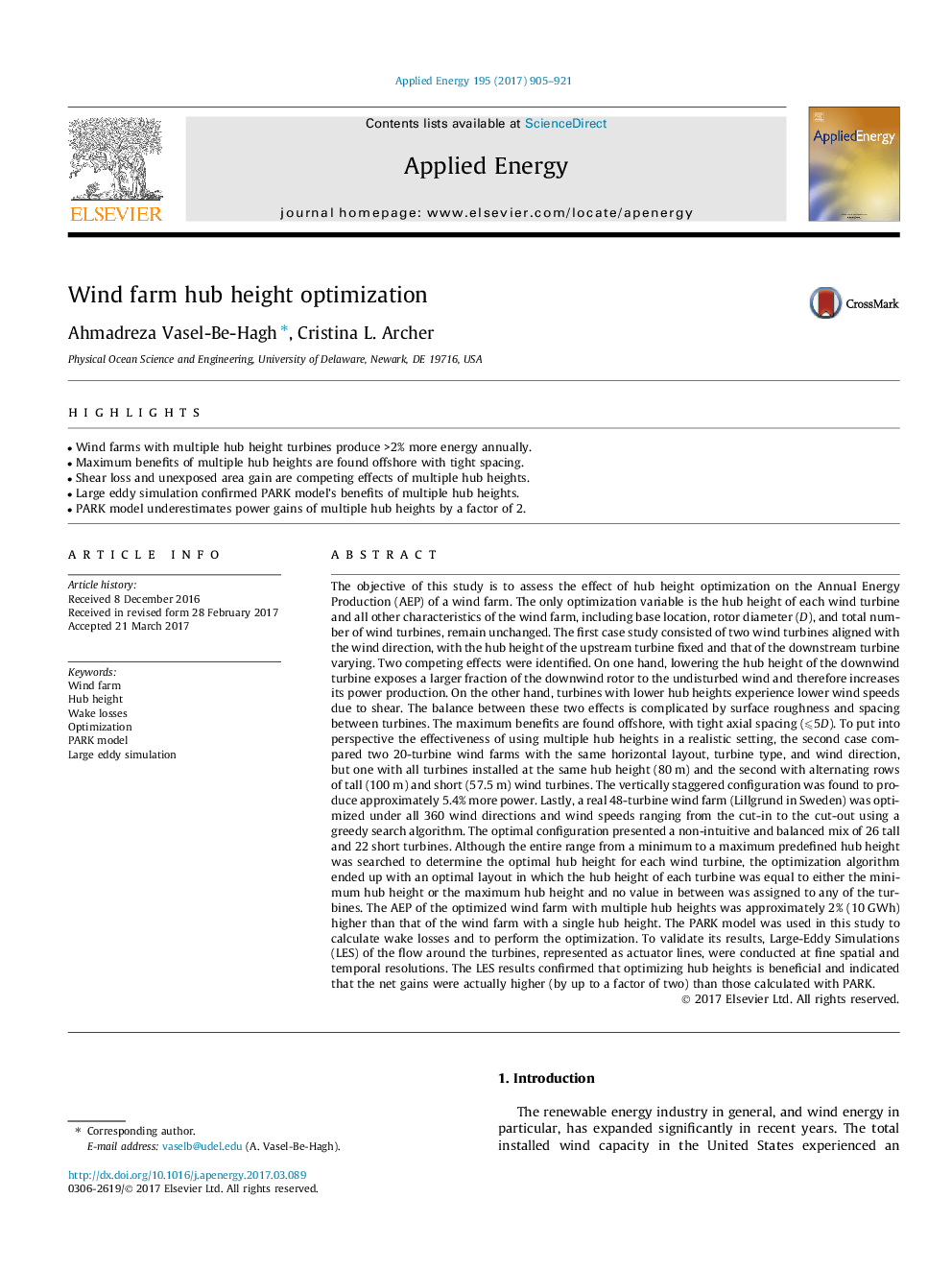| کد مقاله | کد نشریه | سال انتشار | مقاله انگلیسی | نسخه تمام متن |
|---|---|---|---|---|
| 4916530 | 1428095 | 2017 | 17 صفحه PDF | دانلود رایگان |
عنوان انگلیسی مقاله ISI
Wind farm hub height optimization
ترجمه فارسی عنوان
بهینه سازی ارتفاع مزرعه باد مزرعه
دانلود مقاله + سفارش ترجمه
دانلود مقاله ISI انگلیسی
رایگان برای ایرانیان
کلمات کلیدی
موضوعات مرتبط
مهندسی و علوم پایه
مهندسی انرژی
مهندسی انرژی و فناوری های برق
چکیده انگلیسی
The objective of this study is to assess the effect of hub height optimization on the Annual Energy Production (AEP) of a wind farm. The only optimization variable is the hub height of each wind turbine and all other characteristics of the wind farm, including base location, rotor diameter (D), and total number of wind turbines, remain unchanged. The first case study consisted of two wind turbines aligned with the wind direction, with the hub height of the upstream turbine fixed and that of the downstream turbine varying. Two competing effects were identified. On one hand, lowering the hub height of the downwind turbine exposes a larger fraction of the downwind rotor to the undisturbed wind and therefore increases its power production. On the other hand, turbines with lower hub heights experience lower wind speeds due to shear. The balance between these two effects is complicated by surface roughness and spacing between turbines. The maximum benefits are found offshore, with tight axial spacing (⩽5D). To put into perspective the effectiveness of using multiple hub heights in a realistic setting, the second case compared two 20-turbine wind farms with the same horizontal layout, turbine type, and wind direction, but one with all turbines installed at the same hub height (80 m) and the second with alternating rows of tall (100 m) and short (57.5 m) wind turbines. The vertically staggered configuration was found to produce approximately 5.4% more power. Lastly, a real 48-turbine wind farm (Lillgrund in Sweden) was optimized under all 360 wind directions and wind speeds ranging from the cut-in to the cut-out using a greedy search algorithm. The optimal configuration presented a non-intuitive and balanced mix of 26 tall and 22 short turbines. Although the entire range from a minimum to a maximum predefined hub height was searched to determine the optimal hub height for each wind turbine, the optimization algorithm ended up with an optimal layout in which the hub height of each turbine was equal to either the minimum hub height or the maximum hub height and no value in between was assigned to any of the turbines. The AEP of the optimized wind farm with multiple hub heights was approximately 2% (10 GWh) higher than that of the wind farm with a single hub height. The PARK model was used in this study to calculate wake losses and to perform the optimization. To validate its results, Large-Eddy Simulations (LES) of the flow around the turbines, represented as actuator lines, were conducted at fine spatial and temporal resolutions. The LES results confirmed that optimizing hub heights is beneficial and indicated that the net gains were actually higher (by up to a factor of two) than those calculated with PARK.
ناشر
Database: Elsevier - ScienceDirect (ساینس دایرکت)
Journal: Applied Energy - Volume 195, 1 June 2017, Pages 905-921
Journal: Applied Energy - Volume 195, 1 June 2017, Pages 905-921
نویسندگان
Ahmadreza Vasel-Be-Hagh, Cristina L. Archer,
